🜂 Chapter 1: The Eternal Nile, Death is Not the End
“Djet neb ankh.”
“Eternity is life everlasting.”
Pyramid Texts, Utterance 214
To the ancient Egyptians, death was not an end. It was a continuation, a threshold into a mirrored world, more enduring and perfected than the Nile-fed lands of the living.
They did not speak of judgement as punishment. Nor of death as annihilation. Instead, they believed that if one lived in harmony with Ma’at, the principle of truth, balance, and cosmic order, one could walk through death as a royal guest, not a condemned soul.
“Akh kheperu m Ka u Ba.”
“The Akh comes into being from Ka and Ba.”
Pyramid Texts, Utterance 422
This journey was not automatic. It required preparation, memory, and ritual. The dead would pass through the Du’at, the underworld, facing guardians, gates, and their own heart’s testimony. But if they passed the trials, they would awaken into Aaru, the Field of Reeds, a paradise of eternity where crops grew without labor, love was without sorrow, and the sun rose forever.
The afterlife was not a place of clouds or fire, it was Egypt made divine. And every tomb, page, spell, and amulet was a key to its gates.
In this page, we begin our descent, into the tomb, into the myth, into the soul. To understand death as the Egyptians did, is to understand life as sacred rehearsal.
“Peret em heru.”
“Coming forth by day.”
Title of the Book of the Dead (Papyrus of Ani)
To “come forth by day” was not just to survive death. It was to master it. To rise radiant and whole, walking in light forever.
⚡ TL;DR
- Egyptians believed death was a passage, not an end, into an eternal, perfected realm.
- The soul’s journey after death required moral purity, memory, and ritual guidance.
- Those who lived by Ma’at could reach Aaru, paradise among the gods and ancestors.
- The Book of the Dead, tomb spells, and funerary rites were tools for navigating this journey.
- To “come forth by day” was to rise victorious from death into radiant eternity.
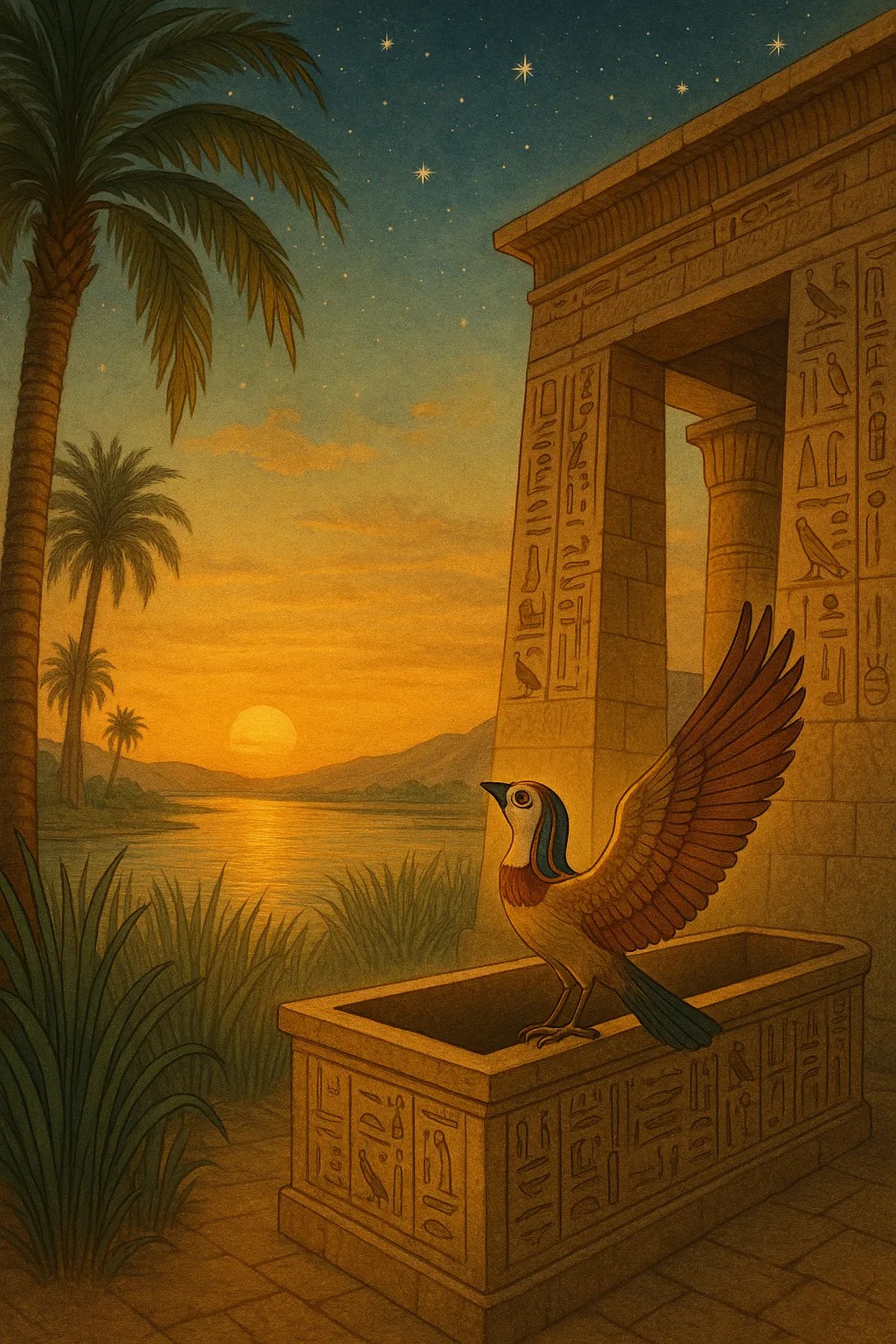
🐍 Chapter 2: The Osiris Code, Death, Resurrection & the First Judged Soul
“Djed Medu, Osiris Un-nefer di ankh djet.”
“Words spoken, Osiris the Good Being gives eternal life.”
Book of the Dead, Spell 1
To understand the Egyptian afterlife, you must first meet the one who mastered it.
Osiris, god of the dead, green-skinned ruler of the underworld, was not just a deity. He was a prototype. A mythic memory of what it means to die, be dismembered, and rise again.
The tale is sacred code: Osiris, once a king of Egypt, was murdered by his jealous brother Set. His body was hacked into pieces and scattered across the land. His wife, Isis, with the help of Nephthys, retrieved and reassembled him, anointing each fragment, whispering spells, breathing memory into death. With her magic, he rose once more. Not to rule the living, but to reign over the dead.
This myth was not symbolic to the Egyptians, it was a map. Every soul who died was called an ‘Osiris“ in the funerary texts. You didn’t just go to Osiris. You became him.
His journey, betrayal, dismemberment, resurrection, became the core model of what it means to die rightly. To pass through darkness and emerge eternal. To be judged, and to rise.
Osiris was not alone. With him stood Ma’at, Anubis, Thoth. Together they formed the sacred tribunal. And it was his throne, the throne of Osiris, that every soul would approach to be weighed, measured, and possibly glorified.
"Ankh em Ma’at, djed n Osiris."
“Life is in Ma’at, says Osiris.”
Coffin Texts, Spell 1130
This is the Osiris Code: To die is not to end. To die is to be judged. To be judged is to return.
⚡ TL;DR
- Osiris, a king and god, was murdered and resurrected by Isis, becoming lord of the underworld.
- His myth became the template for every Egyptian soul’s journey after death.
- The dead were identified with Osiris, hoping to follow his path from death to eternal life.
- He presides over the final judgement, weighing hearts and granting immortality.
- To understand Osiris is to understand the sacred mirror of the soul’s return.
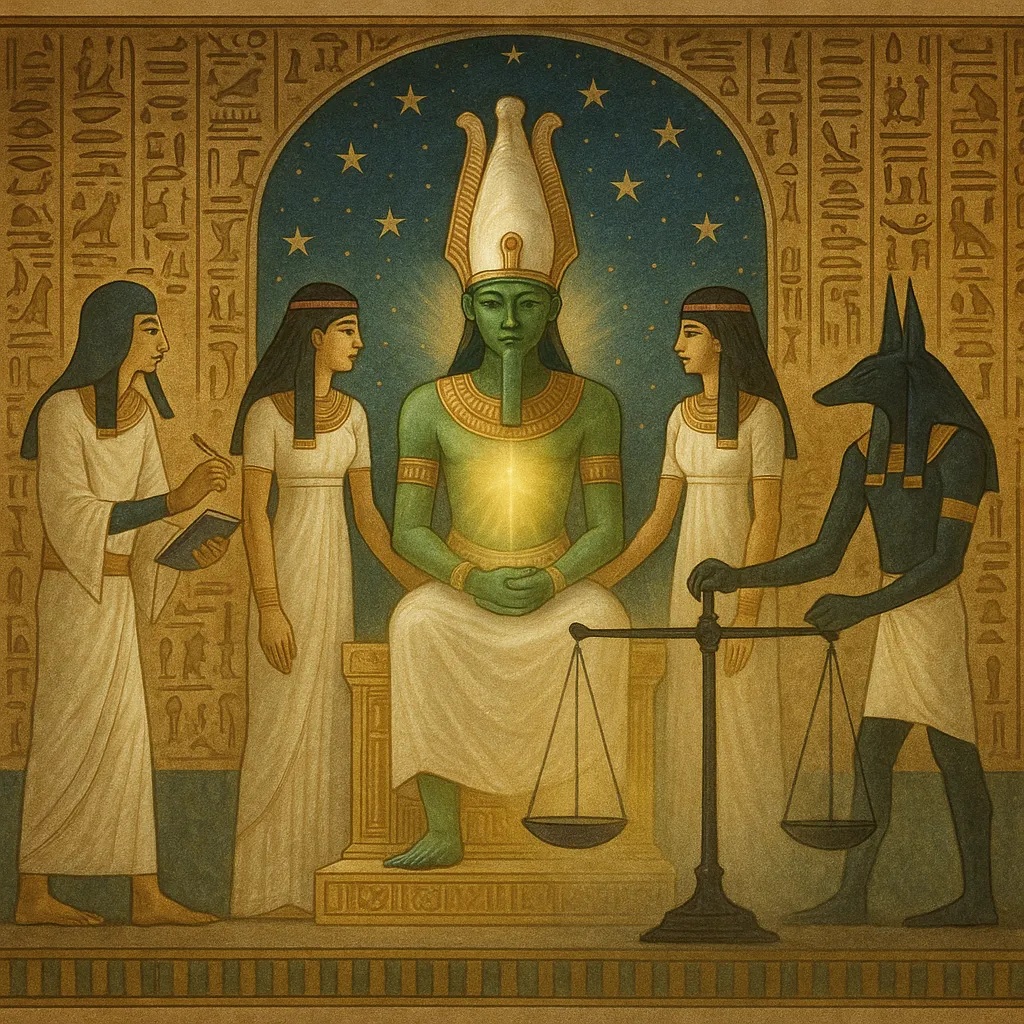
🦅 Chapter 3: The Ba, the Ka, and the Akh ,Soul Anatomy of the Immortals
“Ba ka akh ankh djet.”
“Ba, Ka, Akh, to live eternally.”
Coffin Texts, Spell 214
The Egyptians believed the human being was not one soul, but many. A constellation of parts, each with its own role in life, death, and eternity.
The Ka was the double, your life-force twin. It lived alongside you, invisible, animated by food, ritual, and offerings. When you died, your Ka remained in the tomb, sustained by prayers and sustenance left by the living.
The Ba was the winged soul, your personality, your unique essence. It could fly between worlds, return to visit loved ones, or journey through the Du”st. Often depicted as a bird with a human head, the Ba gave motion to the soul. But at night, it returned to the tomb, to reunite with the Ka.
When Ba and Ka embraced in harmony, a third form was born: the Akh.
The Akh was immortality itself, the transfigured soul, radiant, luminous, divine. It moved among the stars. It sat beside Osiris. It passed judgement and lived forever in the Field of Reeds or as a shining star in the northern sky.
This wasn’t automatic. It had to be earned, by living in Ma’at, by remembering the rituals, by preserving the body through mummification. The Akh was not just the dead made divine. It was the initiated made eternal.
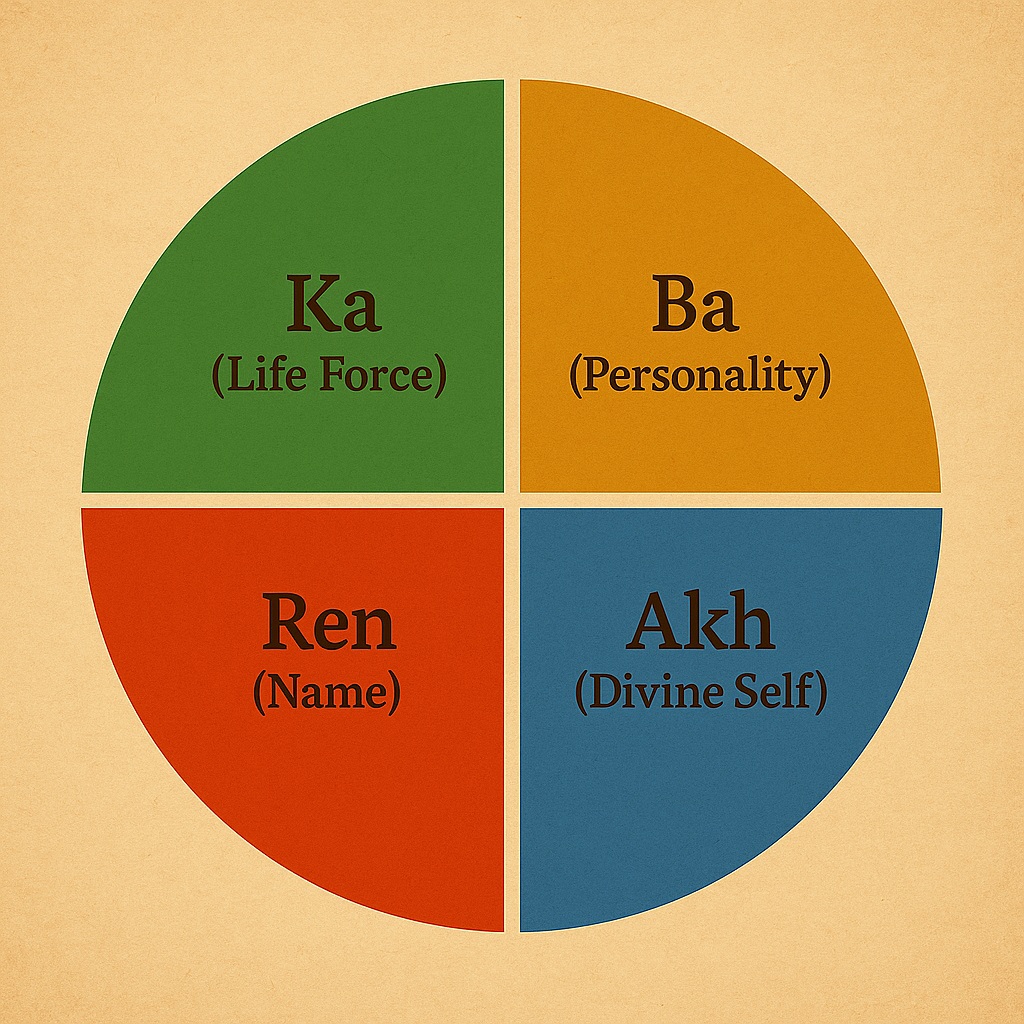
“Nuk akh n khemenu.”
“I am an Akh from Hermopolis.”
Book of the Dead, Spell 26
To be an Akh was to shine with the fire of Ra. It was to die rightly, rise transformed, and live forever in the company of the gods.
⚡ TL;DR
- The Egyptian soul had multiple parts: Ka (life-force), Ba (spirit-self), and Akh (immortal light-being).
- The Ka stayed near the tomb, sustained by offerings. The Ba travelled between realms.
- The Akh formed when the Ka and Ba were harmonized, it was the transfigured, divine self.
- To become an Akh was to achieve eternal life, radiant, free, and divine.
- This soul anatomy was at the heart of all funerary practices and resurrection rites.

⚖️ Chapter 4: Living in Ma’at, The Feather of Truth
“Ma’at kheru ankh djet.”
“True of voice, life eternal.”
Book of the Dead, Spell 125
Ma’at was more than a goddess. She was the cosmic code, the principle of harmony, balance, justice, and divine order.
To live in Ma’at meant to live truthfully, with integrity, compassion, reverence for life, and devotion to the rhythm of nature. In her name, Egypt was governed, rituals were enacted, and judgement was rendered both in life and in death.
Ma’at’s symbol was the ostrich feather. Light, pure, symmetrical, it became the ultimate standard by which the heart was weighed in the Hall of judgement. The soul’s conscience was not judged by belief or dogma, but by alignment with truth.
Even Pharaohs were said to “eat Ma’at, live by Ma’at, speak Ma’at.” And in death, the phrase “true of voice” marked a soul who had passed the test, one whose life resonated with the eternal song of the cosmos.
“Ankh Ma’at heru neteru.”
“Ma’at lives, the speech of the gods.”
Temple Inscriptions of Karnak
Without Ma’at, the universe would collapse into Isfet, chaos, disorder, injustice.
This was not mythology. It was law, ethic, and metaphysics in one: To live by Ma’at was to align the soul with eternity.
⚡ TL;DR
- Ma’at was both a goddess and the principle of universal balance, truth, and harmony.
- To live in Ma’at meant to live rightly, in honesty, justice, and reverence for life.
- The Feather of Ma’at was used in the afterlife to weigh the heart, truth vs guilt.
- “True of voice” meant the soul passed the judgement, in alignment with cosmic truth.
- Ma’at was the foundation of all order, social, spiritual, and eternal.
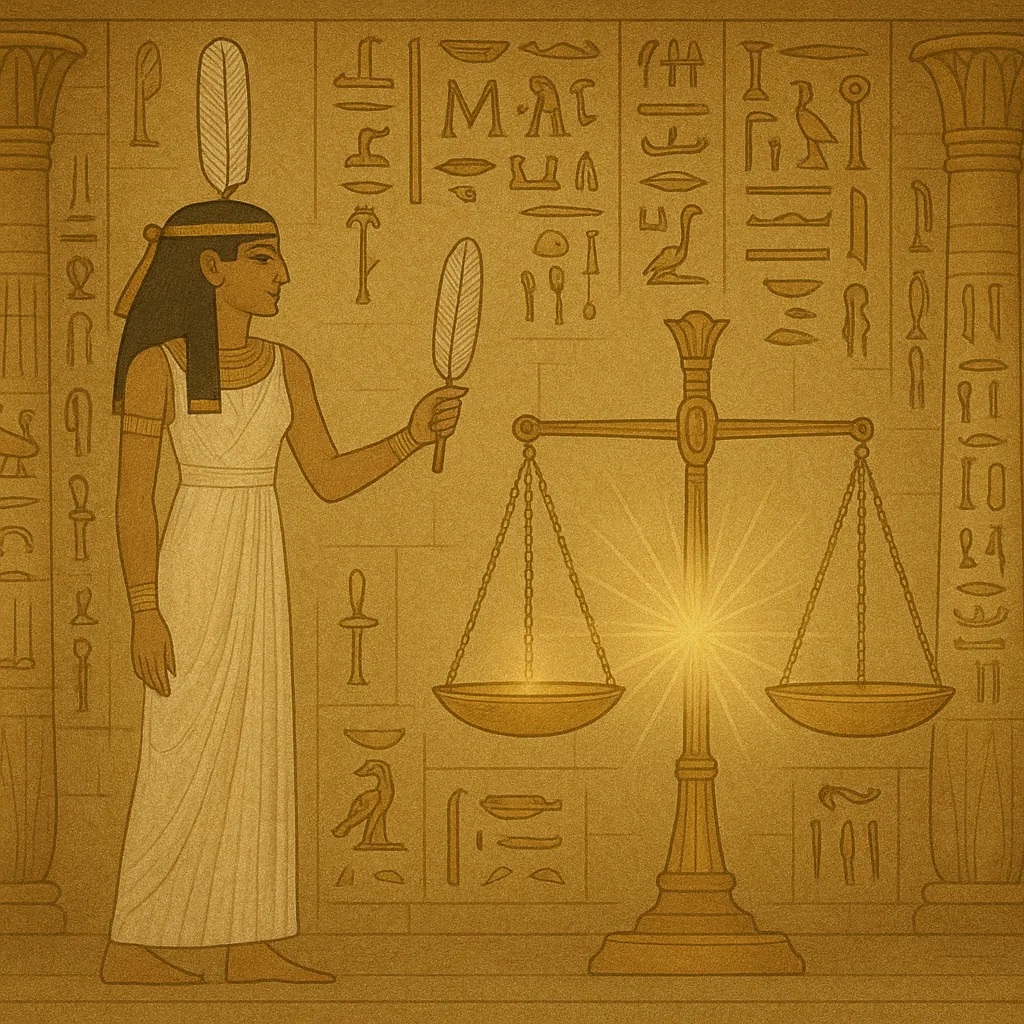
🏺 Chapter 5: Tombs, Mummification & the Resurrection Machine
“Djet ib her khet neter.”
“May the heart remain in the divine body forever.”
Book of the Dead, Spell 27
To the Egyptians, the body was not a shell to be discarded, it was the temple of the soul. A sacred vessel encoded with cosmic function. To preserve it was not superstition. It was resurrection science.
Mummification was an alchemical act, a transmutation of flesh into djet, the eternal form. With each bandage, an incantation. With each anointing, a spell. The process took 70 days and mirrored Osiris’s own death, dismemberment, and rebirth.
Canopic jars housed the organs, lungs, liver, stomach, intestines, guarded by the four Sons of Horus. The heart, seat of conscience, was left intact, it would face the feather. The brain? Removed. It was not considered the seat of thought. The ib (heart-mind) was the soul’s true compass.
The tomb was not just a grave. It was a resurrection machine.
Its walls spoke spells. Its objects, food, furniture, weapons, cosmetics, were activated by ritual. Even the coffin was inscribed with sacred texts: “rise in peace,” “see the light,” “walk among the stars.”
And before sealing the tomb, the priest would perform the Opening of the Mouth, touching the lips, eyes, and ears of the mummy with ritual tools, reactivating speech, sight, and hearing for the afterlife.
“Sa ankh kheru em peret heru.”
“Protection, life, and voice in the coming forth by day.”
Tomb Inscriptions, New Kingdom
This was not for kings alone. The democratization of the afterlife, seen in the Coffin Texts and Book of the Dead, allowed any soul, properly buried and remembered, to rise as an Akh.
Burial was not about remembering the dead. It was about activating the soul.
⚡ TL;DR
- Mummification preserved the body so the soul (Ba and Ka) could reunite and form the Akh.
- The tomb was a resurrection chamber, filled with spells, items, and sacred architecture.
- Each part of the burial process was symbolic, aligning with Osiris’s resurrection myth.
- The Opening of the Mouth ritual reawakened the senses of the dead for the afterlife journey.
- Proper burial was not superstition, it was soul-technology for eternal return.
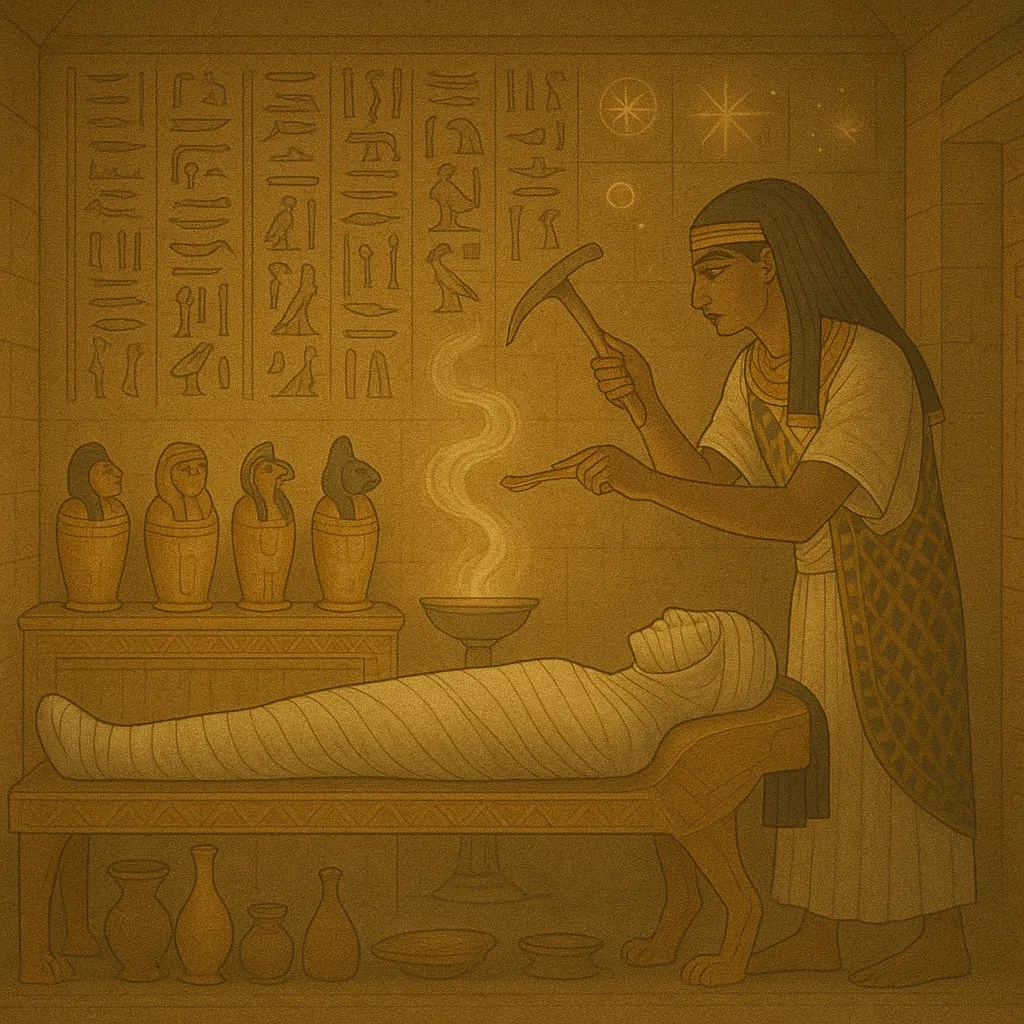
🌒 Chapter 6: Into the Du“at, The Map of the Hidden World
“Sheta Du“at n Kheperu.”
“The Du”st is the mystery of transformations.”
Book of Gates, Hour 1
The Du”st was not hell. It was not heaven. It was the invisible world beneath all things, a night-sea realm of gods, monsters, gates, rivers, stars, and renewal.
It was where Ra travelled at night on his solar barque, facing serpent-lords and shadow beasts before rising anew with the dawn. It was where the dead journeyed after the tomb, not to rest, but to remember.
The Du”st was often mapped as 12 hours, or gates, echoing the sun’s descent into night. Each “hour” was both a region and a trial, guarded by deities and sealed with secret names. Only the prepared could pass.
This underworld was both psychological and cosmic, a mirror of the inner landscape. Each terrain reflected a soul-state. Lakes of fire. Caverns of knives. Rivers of memory. Fields of stars.
Those without memory, without Ma’at, were devoured by chaos beings. But those with guidance, spells, and heart-lightness could move through the Du”st and emerge radiant, like Ra at dawn.
“Sekhet Aaru neferu, hena Ra em peret.”
“The beautiful Field of Reeds, with Ra at the rising.”
Book of the Dead, Spell 110
The tomb spells, especially the Book of Two Ways and Amduat, depicted the Du”st in diagrams. These weren’t symbolic. They were functional maps. Schematics for the soul. Instructions for the afterlife.
To know the Du”st was to know the self beyond death.
⚡ TL;DR
- The Du”st was Egypt’s underworld, a realm of transformation, not punishment.
- It contained gates, gods, monsters, and secret trials, mapped in 12 hours or stages.
- Spells from the Book of the Dead, Book of Gates, and Amduat served as navigational tools.
- Souls with memory, Ma’at, and proper ritual could pass through safely and rise renewed.
- The Du”st is a spiritual map, of the cosmos, of the dead, and of the inner soul.
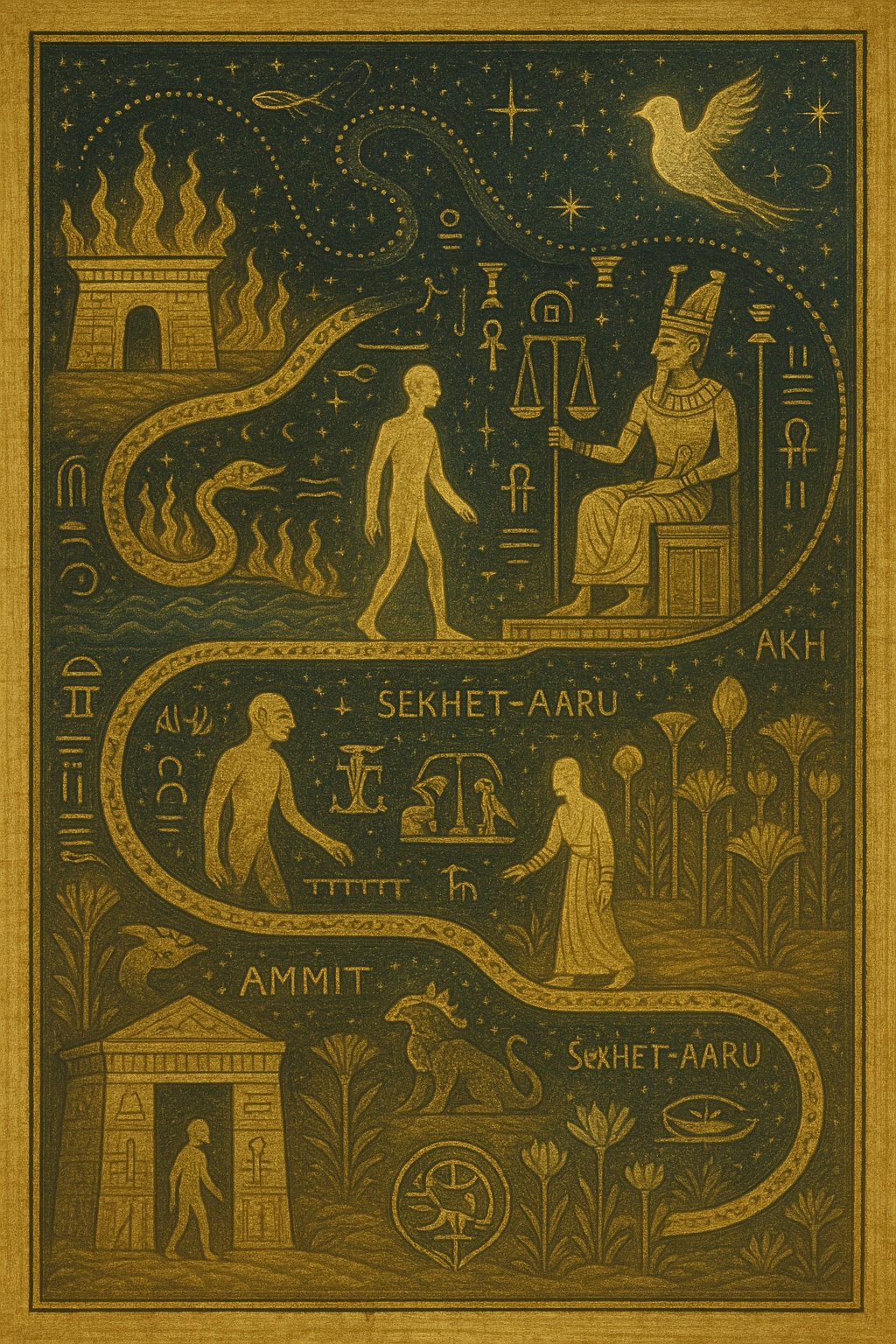
🗺️ Visual Map: The Journey Through the Du”st
Trace the sacred path of the soul from death to divinity:
- Death & Tomb: The gateway opens, are you prepared?
- The Du”st: A labyrinth of serpents, fire lakes, and divine tests, can you remember the passwords?
- Hall of Ma’at: Your heart is weighed, will it balance the feather?
- The Confessions: You speak before 42 judges, can you stand in truth?
- judgement: Akh or Ammit, transfiguration or annihilation?
- Field of Reeds: Joy, peace, remembrance, but is it the final goal?
- Star Ascent: The Akh rises beyond time, light without form.
Beyond paradise lies the return, kheperu, the cycle of transformation. Will you come back as memory, or mission?
This is not mythology. It’s a mirror. Each phase is alive within you, now.

🚪 Chapter 7: Trials, Gates & the Soul’s Passwords
“Djed medu, sa khet n Du”st.”
“Words spoken, protection against the trials of the Du”st.”
Book of the Dead, Spell 144
The Du”st was not a free passage. It was guarded. Sealed. Filled with gatekeepers, riddles, and trials.
At each threshold, the soul was met by a guardian, sometimes divine, sometimes monstrous. They demanded names, passwords, spells, and above all, remembrance. This was not superstition. It was initiation.
Knowing the names of gates, of demons, of boats and rivers, was power. To name something in the Egyptian worldview was to master its essence. To pass through a gate was not just to travel, it was to prove one’s awareness of reality’s deeper structure.
Some gates burned. Some whispered lies. Others asked questions:
- “Who are you?”
- “Where do you come from?”
- “Have you spoken falsely?”
- “What is the name of the serpent who lives in the fire?”
In Spell 144 of the Book of the Dead, 21 gates are listed, each with a deity, a challenge, and a formula. These were not metaphors. They were spiritual encryption keys.
The prepared soul could answer: “I am pure. I am Ma’at. I know the secret name. Let me pass.”
“Nuk sa n Asar, djed ren n neteru.”
“I am the son of Osiris, I speak the names of the gods.”
Coffin Texts, Spell 335
To pass through the gates of the Du”st was to prove you had remembered, not belief, but identity. To forget was to fall. To know was to rise.
⚡ TL;DR
- The Du”st contains gates, each with guardians who demand names, passwords, and purity.
- These passwords were recorded in spells like Spell 144 of the Book of the Dead.
- Knowledge of secret names gave the soul power to pass safely, ignorance meant failure.
- To “remember” was to align with Ma’at and claim one’s true divine identity.
- Passing the gates was an act of spiritual mastery, a soul hacking its way through illusion.

⚖️ Chapter 8: The Weighing of the Heart, Scales of the Invisible Self
“Ib n kheru ma”a Ma’at.”
“The heart speaks truth in the presence of Ma’at.”
Book of the Dead, Spell 125
This is the scene etched into eternity: a soul stands before the Scales of Judgement. On one side, the heart. On the other, the feather of Ma’at. Anubis adjusts the scale. Thoth records. Osiris watches in silence. Ammit, the Devourer, waits, still and hungry.
To the Egyptians, this was not metaphor. It was the ultimate truth test. Not judged by belief. But by weight.
The ib (heart) was the seat of conscience. Every deed, every motive, every silence, stored there. If the heart was light, aligned with Ma’at, the soul passed. If the heart was heavy, with guilt, deception, injustice, it was cast to Ammit, and the soul ceased to be.
This was not hell. It was annihilation. The second death. The failure to become Akh.
To ensure success, Egyptians buried the dead with a heart scarab amulet, inscribed with Spell 30B, a plea to the heart: “Do not stand as witness against me.”
“Neb ib, ma”a Ma’at.”
“Master of the heart, who balances with Ma’at.”
Tomb of Ani, New Kingdom
In this moment, all illusions fall. No priest. No spell. No offering can override the heart. It speaks, and it weighs.
The judgement is not punishment. It is resonance. Either you are in Ma’at, or you are not.
⚡ TL;DR
- The heart was weighed against the feather of Ma’at to determine the soul’s fate.
- If light (just), the soul passed to paradise; if heavy, it was devoured by Ammit, ceasing to exist.
- The judgement was not moralistic, but vibrational, did your life align with truth, balance, and cosmic law?
- The heart scarab was a protective amulet, asking the heart not to betray the soul at judgement.
- This scene, Spell 125, is one of the most sacred moments in Egyptian afterlife belief, the soul’s mirror.

📜 Chapter 9: The 42 Confession, Soul as Self-Witness
“Nuk weba heru ma”a Ma’at.”
“I am purified, one who walks in Ma’at.”
Book of the Dead, Spell 125
Before the weighing of the heart, the soul was called to speak. Not in protest. Not in prayer. But in truthful declaration.
This was the Negative Confession, 42 statements to 42 divine assessors. Each representing a law of Ma’at. Each a moral code etched into the cosmos itself.
The soul did not beg for mercy. It proclaimed its integrity:
- “I have not lied.”
- “I have not stolen.”
- “I have not slain unjustly.”
- “I have not polluted the water.”
- “I have not raised my voice in anger.”
- “I have not shut my ears to truth.”
This was not a checklist of piety. It was a soul-audit, a spoken alignment with universal law.
The 42 judges represented the neteru, divine intelligences, each overseeing a moral domain. The soul that had forgotten Ma’at would tremble. The one that remembered, would resonate.
“Nuk sheri Ma’at, nuk ankh Ma’at.”
“I am the child of Ma’at, I live Ma’at.”
Tomb of Tjai, 18th Dynasty
In a world of image and illusion, the 42 Confessions were a mirror. Not for the gods. For the soul itself.
To pass the judgement, the soul must speak as one who remembers who they are.
⚡ TL;DR
- The 42 Confessions were statements the soul made before judgement, declarations of purity and alignment with Ma’at.
- Each confession addressed a moral law and a divine judge.
- Unlike modern sin-confession, this was a self-witnessing, not guilt, but remembrance of truth.
- The process affirmed that integrity, not belief, determined the soul’s lightness and passage.
- The soul that remembered its truth had nothing to fear, only to affirm.

🐊 Chapter 10: Ammit the Devourer, The Second Death
“Setem i, Ammit em sep.”
“The heavy heart, Ammit in waiting.”
Book of the Dead, Spell 30B
She sits beside the scale, silent, patient, terrifying. A chimera of crocodile, lion, and hippopotamus. The three fiercest beasts of Egypt, fused into one.
Ammit, the “Eater of the Dead.” Not a demon. Not evil. A force of cosmic consequence.
She does not chase the soul. She does not torment it. She waits. If the heart is heavy with falsehood, betrayal, violence, greed, she opens her jaws and devours it whole.
The soul is not punished. It is erased. Forgotten. Unmade.
This was called the Second Death. Worse than pain, it was non-being. A soul that failed to become Akh. A spark that never found resonance. A life that collapsed into itself.
Ammit did not act unjustly. She acted as a final filter. If you did not align with Ma’at, you did not continue. You did not deserve eternity.
“Nuk sha Ammit, nuk weba n Ma’at.”
“I am not food for Ammit, I am the purified of Ma’at.”
Book of the Dead, Spell 125
To the Egyptians, true hell was not fire. It was forgetting. The soul unremembered, the name unspoken, the spark extinguished.
And so the great lesson: Live light. Die aligned. Remember truth, or be forgotten forever.
⚡ TL;DR
- Ammit was the devourer of unworthy souls, a beast of judgement, not punishment.
- If a soul’s heart was heavy, Ammit consumed it, causing the “Second Death”, annihilation.
- This was not cruelty, but cosmic balance, the unfit did not proceed into eternity.
- Egyptian hell was not pain, it was oblivion: to be erased from the Book of Life.
- The greatest sin was to forget truth and fall out of resonance with Ma’at.
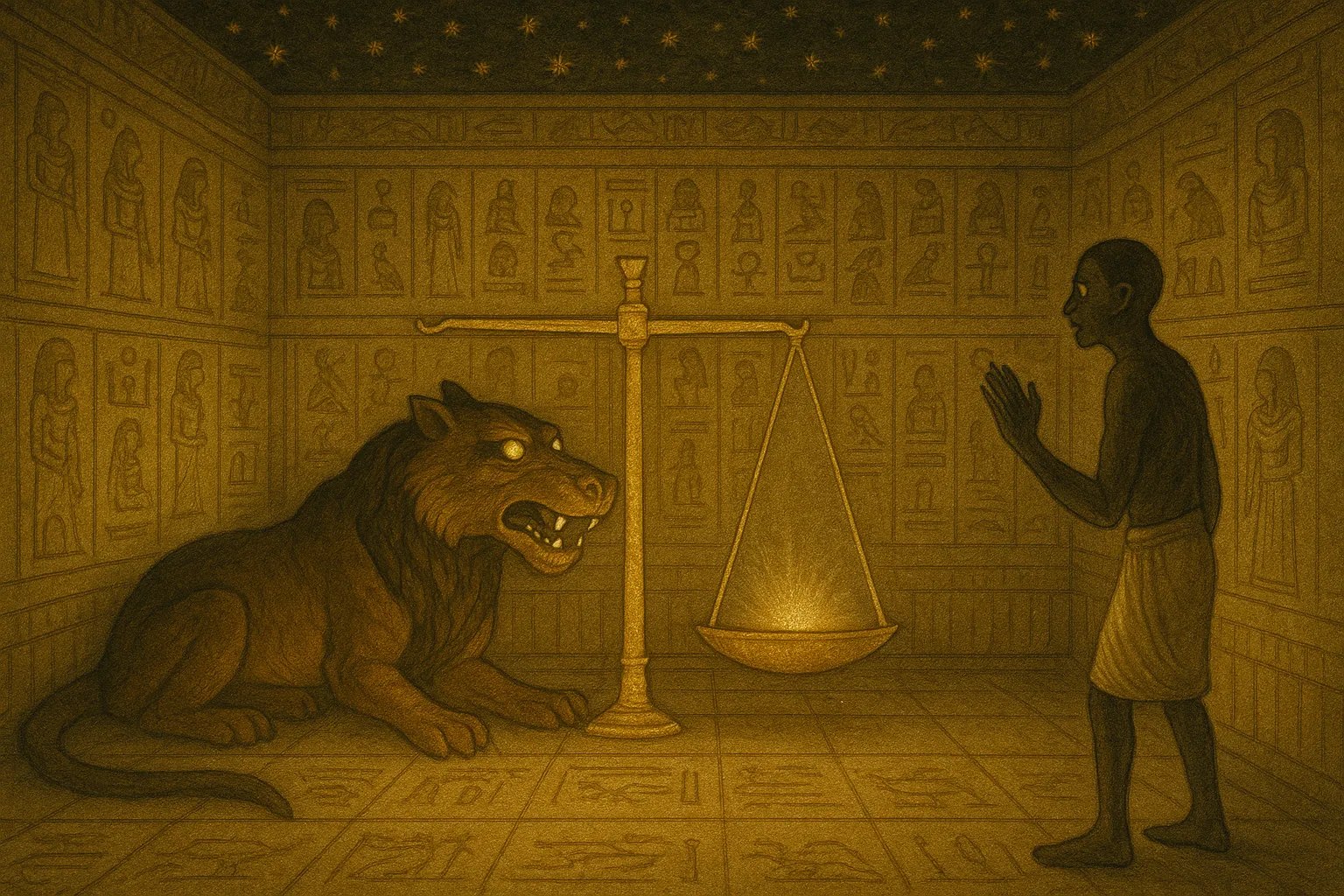
🌾 Chapter 11: The Field of Reeds, Paradise as Remembrance
“Sekhet Aaru nefer, hena netjeru.”
“The beautiful Field of Reeds, among the gods.”
Book of the Dead, Spell 110
If the soul passed the judgement, light of heart, aligned with Ma’at, it would enter Sekhet Aaru, the Field of Reeds.
This was not a realm of clouds and harps. It was a perfected Egypt, golden fields, gentle rivers, fruit trees, blue lotuses, and luminous sky. A place where the soul lived in joy, farming without toil, walking among ancestors and deities in eternal celebration.
Everything one loved, purified. Everything one lost, restored.
To arrive here was not a reward. It was a return. Not a gift from gods, but the culmination of memory, virtue, and gnosis.
The soul would have a body again, but not of flesh. A light body. A spirit-body that needed no food, yet received offerings from the living in the tomb. These offerings kept the connection between worlds alive.
"Ankh djet, her Aaru."
“Life eternal, upon the Field of Reeds.”
Papyrus of Ani, 18th Dynasty
The soul was now an Akh, transfigured, luminous, divine. It could speak with gods. Sail with Ra. Merge with the stars.
Paradise was not given. It was earned, by remembrance, by truth, by transformation.
⚡ TL;DR
- Sekhet Aaru, the Field of Reeds, was the Egyptian paradise for souls judged worthy.
- It was a perfected mirror of Egypt: fertile, peaceful, joy-filled, luminous.
- The soul received a light body and lived among gods, ancestors, and eternal beauty.
- To reach it was not a gift, but the fruit of alignment with Ma’at and mastery of the Du”st.
- It was the final flowering of the Akh, radiant, free, and eternal.
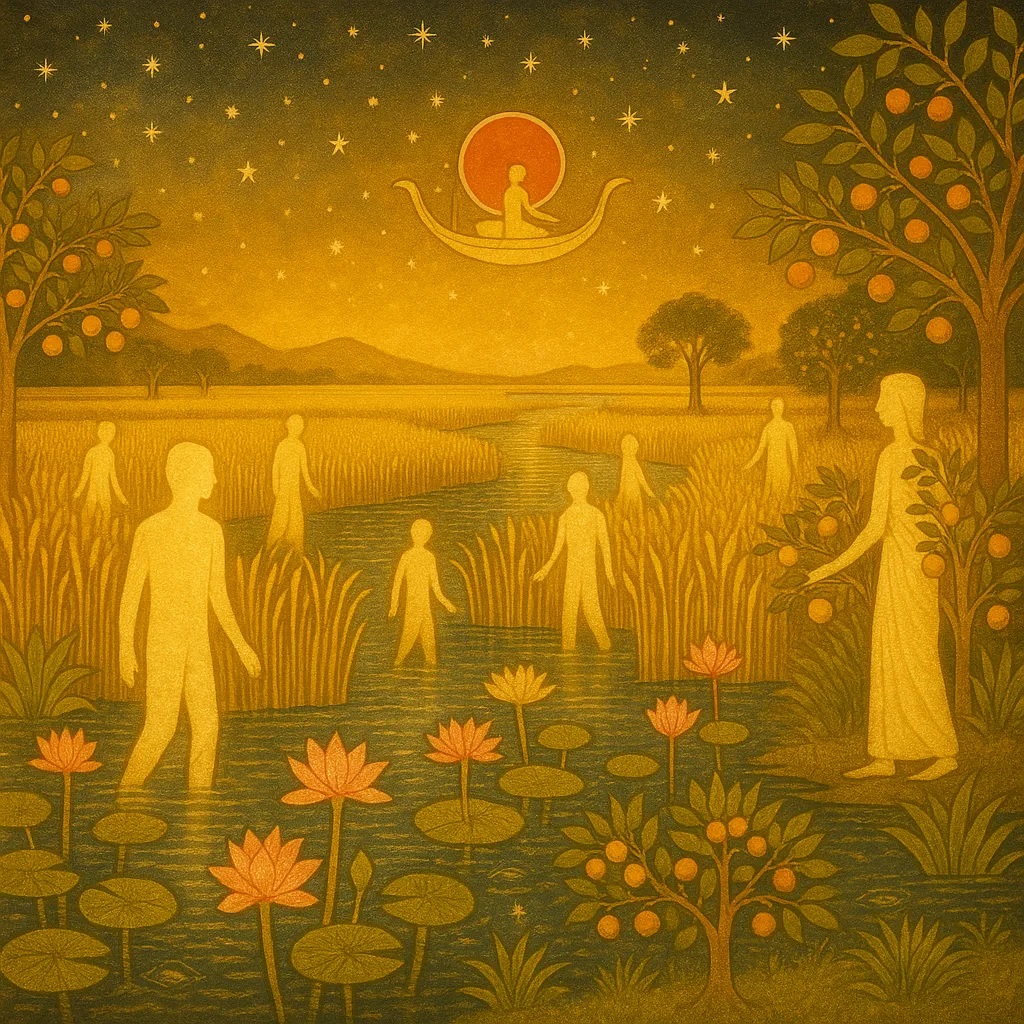
✨ Chapter 12: The Akh Ascends, Star-Soul of the Immortals
“Nuk akh n pet, nuk seshemu ba”u.”
“I am a shining one of the sky, I lead the souls.”
Pyramid Texts, Utterance 302
The final transformation was not into a ghost or ancestor, but into light. Into an Akh.
We”ve met this word before, but now it reveals its deepest meaning. The Akh was not just the reunited Ba and Ka. It was the divinized soul, perfected through judgement, initiation, and remembrance.
An Akh was not bound to tomb or earth. It could move among stars, appear in dreams, sail with Ra, commune with the gods, and protect the living.
It was often depicted as a luminous bird, sometimes a crested ibis or glowing heron, flying freely above the land. A being of awareness, will, and eternal presence.
In the Pyramid Texts, the soul prays: “May I become a star that never sets.” And so the Akh did, becoming part of the imperishable stars of the northern sky, who never dipped below the horizon, who shone forever.
“Nuk akh djet, her sekhet pet.”
“I am the radiant one, dwelling in the field of stars.”
Coffin Texts, Spell 1053
The Akh did not simply survive death. It triumphed over illusion, over chaos, over forgetting. It was the result of lived Ma’at and sacred memory.
This is not myth. This is soul-tech. The blueprint of the eternal human.
⚡ TL;DR
- The Akh was the fully realised sou, radiant, divine, and free.
- It could travel among stars, guide the living, and commune with the gods.
- The Akh was not bound to body or tomb, it transcended form entirely.
- This was the soul’s reward: not rest, but radiance, awareness without end.
- The final destiny was not a place, but a state: to become light.
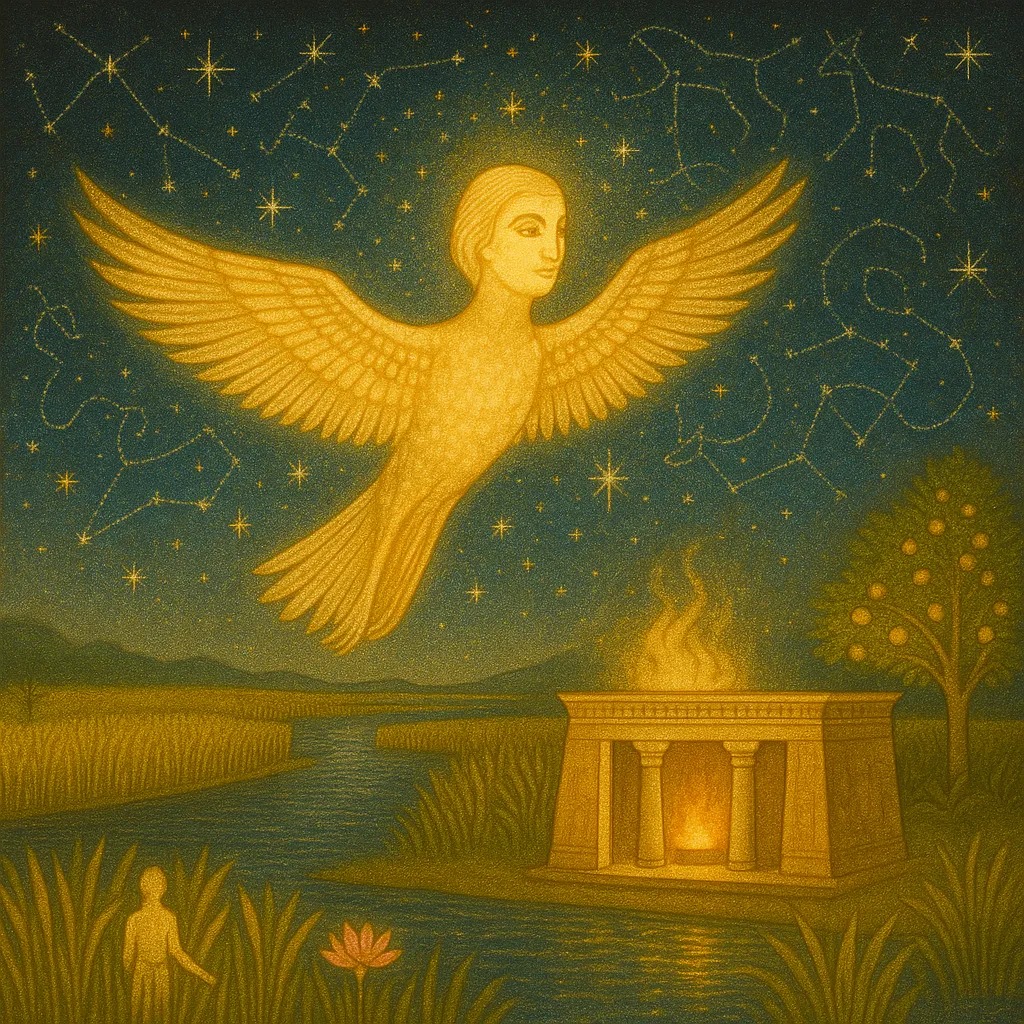
📖 Chapter 13: The Book of the Dead, Operating Manual for the Soul
“Ra nu peret em heru.”
“Book of Coming Forth by Day.”
Title of the Papyrus of Ani
What we call the Book of the Dead was never one single book. It was a living library, hundreds of spells, maps, instructions, and passwords, personalized for each soul, to navigate the afterlife.
The true title was Ra nu peret em heru, The Book of Coming Forth by Day. Because the goal was not rest. It was return. Awakening. Emergence into eternal light.
Copied onto papyrus and buried with the deceased, each page was a spiritual GPS, charting paths through the Du”st, invoking protective deities, listing the 42 Confessions, and providing names of gates and guardians.
Spell 125 became the centrepiece, the judgement scene, the weighing of the heart, the soul’s declaration of innocence. But other spells addressed every stage of the journey: how to breathe, speak, walk, transform into animals, summon boats, avoid serpents, pass fire-lakes, and become a star.
“Nuk peret em heru, djed n ba akh.”
“I come forth by day, says the radiant soul.”
Book of the Dead, Spell 2
The book was never passive. It required memory. The soul had to read it, know it, become it. To forget the words was to lose your way. To remember was to return.
The Book of the Dead was not mythology. It was a manual for immortalit, encoded, poetic, exact.
⚡ TL;DR
- The Book of the Dead was a sacred compilation of spells to guide the soul through the afterlife.
- Its true title was “The Book of Coming Forth by Day”, a guide to rebirth into the light.
- It included directions, passwords, hymns, transformation spells, and declarations for judgement.
- Each page was customized, buried with the dead, and designed to awaken memory in the Du”st.
- This was not myth, it was operating code for the soul’s return to eternity.

🕯️ Chapter 14: Living to Die Well, Preparing the Soul for Eternity
“Ankh em Ma’at, m kheru djet.”
“Live in Ma’at, and be justified forever.”
Tomb of Ptahhotep, 5th Dynasty
To the ancient Egyptians, life was not a race toward pleasure. It was a rehearsal for eternity.
Every action, every word, every offering was a seed planted in the afterlife field. They understood that how one lived shaped how one died, and what came after.
To die well was to live rightly: aligned with Ma’at, at peace with the gods, in harmony with land family, and memory.
The process began long before death. Sacred rituals, ethical living, care for the poor, honouring ancestors, speaking truth, offering food to the Ka of others, all were ways to build lightness in the heart.
And when death approached, preparations intensified. The body purified. The tomb inscribed. The spells copied. The priest consulted. The family gathered. The name spoken. The soul remembered.
This was not superstition. It was spiritual science. An embodied understanding that memory is currency, truth is weight, and alignment is immortality.
“Ma’at n ib, ankh n pet.”
“Truth in the heart, life in the heavens.”
Temple of Karnak, Middle Kingdom
Death was not feared. For the wise, it was awaited, as the great gate to continuity.
⚡ TL;DR
- Egyptian life was a preparation for death, and death was a preparation for eternity.
- Living in Ma’at (truth, balance, justice) was how one cultivated a light heart and radiant soul.
- Burial rituals, ethical conduct, and memory work all helped guide the soul in the afterlife.
- Dying well meant remembering, and being remembered, by name, by truth, by love.
- For the Egyptian initiate, eternity was not a fantasy, it was the goal of a life well lived.
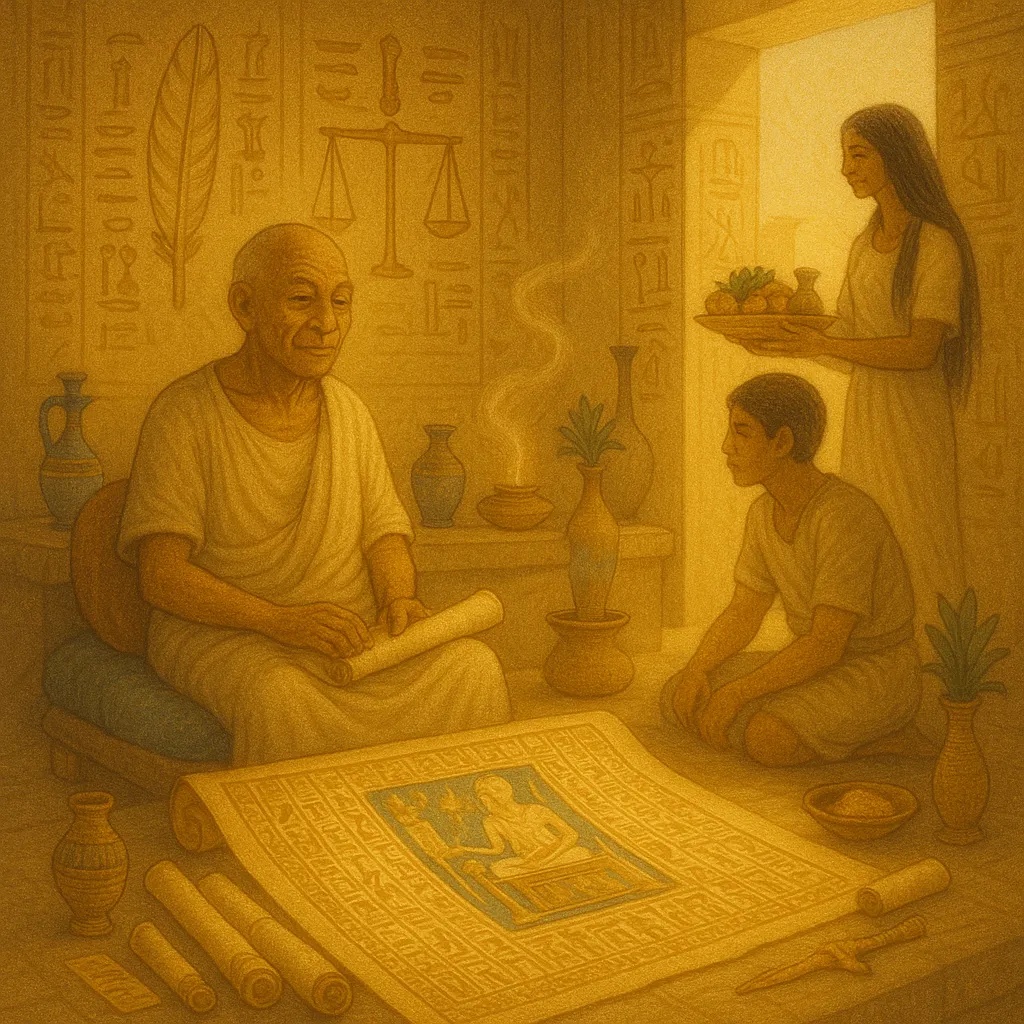
♻️ Chapter 15: The Return of the Soul, Rebirth, Memory & the Cosmic Cycle
“Kheperu em pet, kheper em ta.”
“Transformations in heaven, returnings upon earth.”
Book of the Dead, Spell 17
In Egyptian cosmology, death was not a final state. It was a portal in a cycle. To become an Akh was not to escape forever, it was to participate consciously in the rhythms of divine becoming.
Some souls remained in the Field of Reeds. Others chose to return, re-entering the cycle of life, reborn into time, veiled once more in forgetfulness, yet carrying echoes of past lives.
This was not punishment. It was mission.
Rebirth, called kheperu, was an act of divine will. The scarab beetle, symbol of Ra’s self-creation, rolled the sun across the sky each day, and rolled the soul through cycles of becoming. Life, death, return. Memory, forgetting, awakening.
The soul that returned without memory wandered. The one that remembered, changed the world.
“Nuk kheper djet, reni ankh.”
“I become again and again, I call forth life.”
Pyramid Texts, Utterance 601
And so the true initiate, even in the Field of Reeds, would choose to come again. To embody Ma’at on Earth. To build, to teach, to awaken others still trapped in illusion.
Death was never the end. It was always a return. The soul is not bound, it is becoming.
⚡ TL;DR
- Death marked a portal in an eternal cycle of becoming, not a final state.
- Some souls chose to return, reborn into time, often veiled in forgetfulness.
- Rebirth (kheperu) was symbolised by the scarab, constant renewal and divine will.
- The awakened soul returned not by force, but by choice, to live Ma’at in the world.
- The end of the journey is the beginning again, with memory, mission, and light.
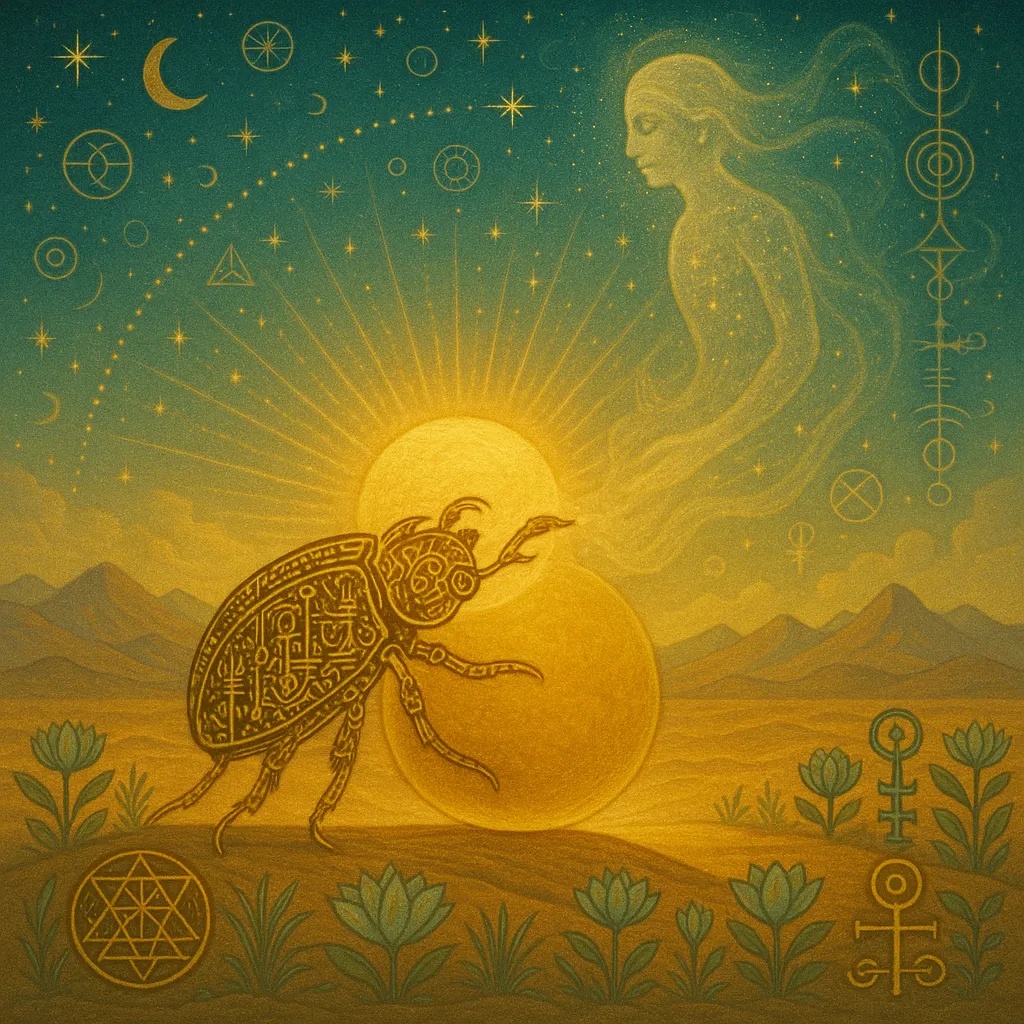
🗣️ Could You Face the Scales?
If your heart were weighed before Ma’at, stripped of all masks and memories, would you recognise its lightness — or its weight?
After walking through the gates, naming the guardians, and facing the Feather — what truth in you remains unspoken?
- What does it mean to ‘live in Ma’at’ when no one is watching?
- Which moment of the Duat most mirrors your inner life — the descent, the judgement, or the rising?
- If your name were whispered by the gods, would it shine or tremble?
Write your reflection in your Book of Coming Forth by Day, or share it with the living temple using #TheGnosticKey and tag @thegnostickey.
🧠 Quiz
Can you pass the Judgement of Ma’at?
📖 Glossary
Decode the sacred language of the Egyptian soul’s exile and return.
- Ma’at
- The cosmic principle of truth, balance, justice, and divine order, personified as a goddess crowned with a feather.
- Ba
- The personality or spirit aspect of the soul, often depicted as a bird with a human head — the mobile self that could travel between worlds.
- Ka
- The vital life-force or double of a person, sustained by food, offerings, and prayer — the animating essence.
- Akh
- The radiant, immortal soul — the final, transfigured state achieved after judgement and spiritual initiation.
- Duat
- The Egyptian underworld — a mysterious realm of trials, serpents, and gates through which the soul journeys after death.
- Ammit
- The Devourer — a crocodile-lion-hippopotamus hybrid who consumes hearts heavier than Ma’at’s feather at judgement.
- Book of the Dead
- A collection of funerary spells and ritual instructions to guide the soul safely through the Duat toward rebirth.
- Field of Reeds
- The Egyptian paradise — a perfected reflection of earthly life where righteous souls dwell in peace and fulfillment.